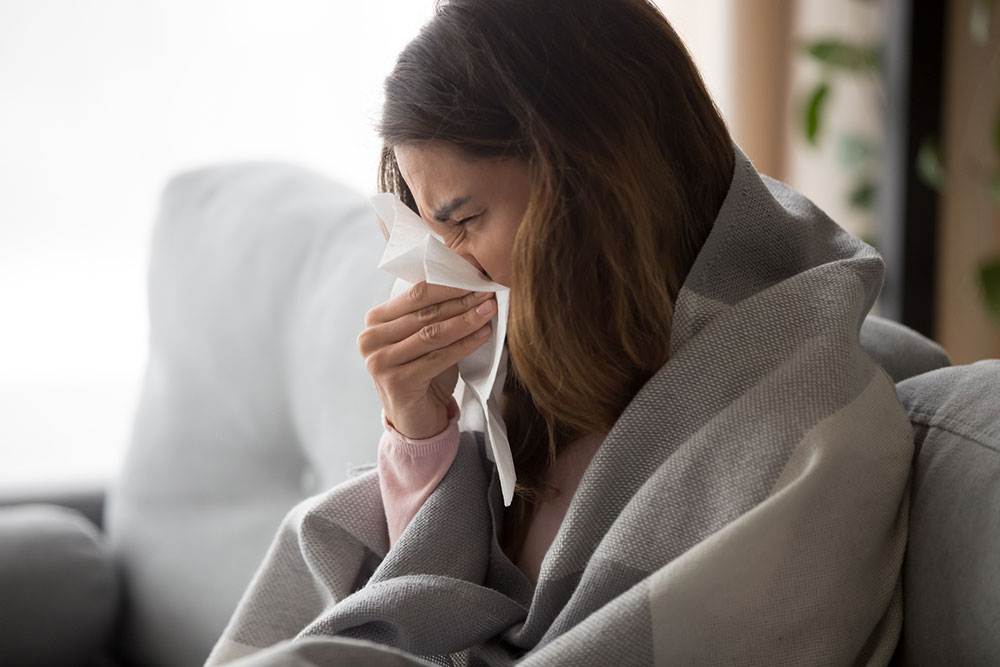14 early signs of severe respiratory viral infections

In recent years, respiratory illnesses have been on the rise, especially those caused by viruses. Such diseases can affect the entire respiratory system, from the sinuses to the lungs. Although some symptoms associated with these conditions tend to resolve on their own, others may require medical intervention. That is why recognizing the symptoms early on and getting timely treatment may help in managing the condition. So, here are 14 early signs of respiratory infections:
1. Fever
A fever is generally one of the first signs of a respiratory infection. It is the result of the immune response to viruses, as many such pathogens are sensitive to temperature changes in the body. Upon noticing this sign, one must consistently monitor their body temperature, as a persistent fever may be an indication of a severe respiratory virus. Here, seeking medical attention is important if the body temperature crosses 100.4°F (38°C). A temperature as high as 101 to 102°F (about 38.3 to 38.9°C) is common for those infected by influenza. However, fevers over 103°F require immediate treatment. At times, this symptom may be accompanied by night or cold sweats. As the internal temperature increases, the body may induce sweating to prevent overheating and help one cool down.
2. Fatigue
Another common sign of a respiratory infection is fatigue or weakness. This symptom can often be dismissed as exhaustion, remaining unnoticed. However, feeling extremely tired, even after a good night’s sleep, can be a symptom of a viral infection. In some cases, fatigue may also bring lethargy and a general feeling of illness or malaise.
3. Cough
A wet or dry cough is among the earliest symptoms to develop when one is infected by a respiratory virus. Often, a mild, dry cough can be treated using home remedies such as steam and hot beverages such as soup or tea. However, if the cough remains persistent and uncontrollable despite preliminary treatment, it may be a sign of a severe infection, warranting medical attention.
4. Wheezing
Wheezing is a high-pitched sound that generally occurs when one breathes out or exhales. This could be a result of blocked airways associated with respiratory illnesses, making it difficult to breathe normally.
5. Shortness of breath
Upon contracting a respiratory virus, some people may also experience dyspnea, that is, difficulty breathing or shortness of breath. As a result, they may prefer sitting up rather than lying down. The symptom can worsen and interfere with daily routine, so one must consult a doctor upon experiencing shortness of breath.
6. Body aches and muscle pain
Those dealing with a respiratory infection may also experience body aches and muscle pain, which may affect their ability to move and perform daily activities. It develops as a result of an immune response that releases more white blood cells to fight the infection. This can cause inflammation in the body, leading to aches and pains in the muscles and joints.
7. Headaches
Viral infections may also cause headaches, varying in intensity, location, and duration. For instance, those with a sinus infection may experience pain in their cheekbones, forehead, or on the bridge of the nose. The pain may worsen if one tries to move or lift their head.
8. Sore throat
Some people may experience pain, scratchiness, or irritation in the throat, especially when they swallow or talk. This is also known as a sore throat, and it is most often a result of a viral infection. Other issues associated with a sore throat are swollen glands in the neck or jaw, swollen or red tonsils, the appearance of white patches on the tonsils, and a hoarse voice.
9. Chest pain and tightness
When viral infections affect the respiratory system, they may block airways, leading to added pressure on the chest. This can cause sensations of pain, soreness, or tightness. When dealing with bronchitis or pneumonia, the viruses may infect the lungs directly. This symptom should be examined by a doctor.
10. Loss of smell and/or taste
Although this is not a common symptom of respiratory illnesses, people have reportedly experienced loss of taste and/or smell when diagnosed with a viral infection in the last few years. This symptom is also known as anosmia. This symptom could require prompt medical testing and isolation.
11. Digestive issues
Common respiratory viruses may also cause gastrointestinal issues such as diarrhea, nausea, or vomiting. These develop because viral infections and their formal treatments may often alter the gut microbiome. However, the incidence and intensity of these symptoms vary greatly from person to person.
12. Disorientation
As the infection progresses, it may lead to neurological symptoms such as confusion or disorientation. This may also be an indicator of hypoxia—low blood oxygen levels.
13. Cyanosis
In extreme cases of respiratory infections, the lips may start turning blue. This is known as cyanosis. It is a key indicator of low blood oxygen levels, requiring emergency medical care.
14. Eye redness or discharge
Some people may also experience red eye (conjunctivitis) from the eyes as a result of a viral infection in the upper respiratory tract. This may be accompanied by discharge or itching.
Prevention
All viral respiratory infections do not present the same symptoms. The appearance of one or multiple of the above-mentioned symptoms warrants medical testing and intervention. This can help identify the illness and monitor its progress accordingly. However, one must also take several steps to keep themselves safe from respiratory infections. It is possible to contain the spread of viral respiratory infections by taking the following precautions, such as:
– Wearing well-fitted masks or respirators to cover the mouth and nose
– Covering the nose and mouth when coughing or sneezing
– Staying away from or limiting contact with those dealing with a respiratory infection
– Avoiding touching the eyes, nose, and mouth throughout the day
– Practicing physical distancing, especially in public places
– Cleaning hands regularly with a sanitizer or soap and water
– Cleaning and disinfecting immediate surroundings regularly







